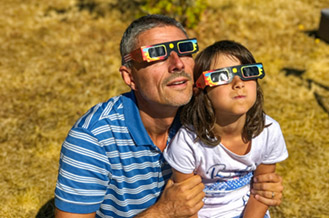
There is much excitement building around the solar eclipse that is coming April 8th. Eye doctors at Ophthalmic Consultants of Boston encourage you to enjoy the spectacle, but do so safely, bearing in mind that eye safety is paramount. The total solar eclipse will move across North America during the afternoon of April 8th, tracking from southern Texas to northern Maine. In a total eclipse, the moon passes between the sun and earth, completely blocking the face of the sun. The sky will darken as if it were dawn or dusk for about 3-4 minutes. A partial solar eclipse will be visible to nearly everyone in North America, depending upon how cloudy it is.
Here in New England, the totality path of the April 8th eclipse will cover northwestern Vermont and parts of New Hampshire and Maine. Viewers in areas from Boston to Providence and elsewhere in New England that are not in the total eclipse path, will see roughly 90 percent of the sun covered, according the Boston Globe.
Staring at the sun is dangerous for your eyes
Looking at the sun without the right eye protection, even for a short time, can cause permanent damage to the retina, a condition known as solar retinopathy. Your eye’s lens focuses light onto the back of your eye (your retina) so you can see clearly. But if you look directly at the sun, that focused light can burn your eye.
Only certified eclipse glasses or viewers that filter out the sun’s damaging rays should be worn
Ordinary sunglasses, no matter how dark, or homemade filters are NOT safe. To safely look directly at the sun, you must obtain solar filters, known as “eclipse glasses” or hand-held solar viewers. These products must meet ISO 12312-2 standards. Visit the American Astronomical Society site and see their list of suppliers of safe eclipse glasses and viewers HERE:
Fake suppliers selling counterfeit products are out there. The AAS put out a press release on March 22, warning about these. You can view it HERE:
Other safety tips
Please see the tips below provided by the American Academy of Ophthalmology and plan ahead to safely watch the solar eclipse:
- Carefully look at your solar filter or eclipse glasses before using them. If you see any scratches or damage, do not use them.
- Always read and follow all directions that come with the solar filter or eclipse glasses. Help children to be sure they use handheld solar viewers and eclipse glasses correctly.
- Before looking up at the bright sun, stand still and cover your eyes with your eclipse glasses or solar viewer. After glancing at the sun, turn away and remove your filter—do not remove it while looking at the sun.
- The only time that you can look at the sun without a solar viewer is during a total eclipse. When the moon completely covers the sun’s bright face and it suddenly gets dark, you can remove your solar filter to watch this unique experience. Then, as soon as the bright sun begins to reappear very slightly, immediately use your solar viewer again to watch the remaining partial phase of the eclipse.
- Never look at the uneclipsed or partially eclipsed sun through an unfiltered camera, telescope, binoculars or other similar devices. This is important even if you are wearing eclipse glasses or holding a solar viewer at the same time. The intense solar rays coming through these devices will damage the protective filter in your solar glasses and put your eyes at risk.
- Talk with an expert astronomer if you want to use a special solar filter with a camera, a telescope, binoculars or any other optical device.
NASA will livestream the eclipse so you have the option of viewing it online HERE
An eclipse map is available HERE
